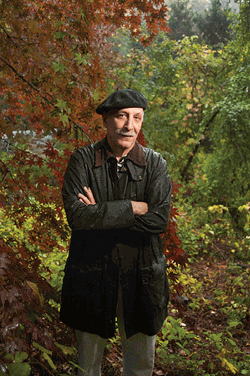Fade in on a well-appointed kitchen on the outskirts of Albany, where Peter Golden is pouring seltzer. "The obligatory tour of the author's lair. That's part of the gig, right?" he asks wryly, ushering me up a carpeted staircase. To the left is a large book-lined study with a counter-sized desk. "That's the nonfiction room," Golden says. To the right, two steps lead to a smaller room, also lined with books. "And that's the novel room."
Golden has spent ample time on both sides of the hall, producing two novels, Wherever There Is Light (Atria Books, 2015) and Comeback Love (Atria, 2012), O Powerful Western Star: American Jews, Russian Jews, and the Last Battle of the Cold War (Gefen Publishing, 2012), and two acclaimed biographies.
Hailed by Kirkus Reviews as "a keenly detailed historical romance," the just-released Wherever There Is Light is the sprawling saga of unlikely lovers Julian Rose, a German-born Jew who made a fortune in Prohibition-era Newark, and Kendall Wakefield, a headstrong, gorgeous African American photographer. The novel room's bookshelves bulge with hundreds of titles on France, World War II and the Holocaust, women photographers, art history, the Negro Press, and other topics infusing the novel's epic sweep.
There are also hints of an equally ambitious novel-in-progress, including a print of Wayne McAllister's iconic 1949 Bob's Big Boy restaurant. Fascinated by postwar futurist architecture, Golden launches into a free-associative riff about the "grand illusion" of Baby Boom prosperity, the infantilization of women after WWII, the nascent Civil Rights movement, the Eichmann Trial revelations, and JFK. "History's got all these threads," he observes; in his fast-moving mind, they interweave fluidly, and there's a story wherever you look.
Heading downstairs, he says, "You missed the Nixon letters," pointing out several framed letters from the former president on the wall. Nixon was an interviewee for Quiet Diplomat (Cornwall Books, 1992), Golden's biography of political insider Max Fisher. He's also interviewed former presidents Ford, Reagan, and G. H. W. Bush, four Secretaries of State, and three Israeli prime ministers; his website boasts a photo of him with Mikhail Gorbachev.
Even at home, he's dressed for a stroll on the Riviera: blue blazer over a striped French navy pullover, khaki pants, Topsiders worn without socks. The home he shares with his wife Annis, chair of SUNY Albany's Communication Department, is impeccably neat, with rolling expanses of carpet. Golden sprawls on an overstuffed chaise, next to a plate of Pepperidge Farm cookies which prove irresistible to Layla, one of two well-loved cats; the second, Rocky Raccoon, dozes in a corner.
It's hard to get a short answer from Peter Golden. Ask him about one of his books, and Spinoza or Nietzsche may make a sudden appearance. Or James Baldwin, or Alexander Hamilton, or WWII photographer and model Lee Miller, one of Golden's inspirations for Kendall.
Or Jewish gangster Longy Zwillman, who not only appears in Wherever There Is Light (alongside other historical figures), but who’s father once had a pushcart on the same Newark street as Golden's great-grandfather. "You have to understand, in the absence of a social service network, you had gangsters," Golden says. "They made sure hungry people got fed."
They also offered protection. When Golden's grandfather, a wholesale fishmonger, got threatened by New York mobsters at the Fulton Fish Market, Zwillman's name calmed the waters. "When he went back the next day, they said, 'Why didn't you tell me who your friends were?'" Golden says, adding, "Julian is a fictional character sort of based on Zwillman."
Julian had other roots too. Years ago, Golden spotted two guys on the Garden State Parkway, cursing out bad drivers. These became prototypes for Julian and his hothead Irish friend Eddie. "Every time I went back to Jersey, I'd think about them. They were just make-believe people I wanted to use in a book."
He also imagined a privileged woman of color as Julian's love interest. "I wanted to look at race backwards," Golden says, noting that America's first female self-made millionaire was hair tonic entrepreneur Sarah Breedlove. "I wanted Julian to be from an impoverished background, a gangster, violent—any of the stereotypes associated with African Americans today." Kendall, by contrast, is "from enormous wealth, with department stores being opened early for her." The issue was how they would ever meet. Gabrielle Simon Edgcomb's book From Swastika to Jim Crow: Refugee Scholars at Black Universities provided an answer. In 1939, after the Nazis expelled hundreds of Jewish scholars from German universities, many were hired by black Southern colleges whose leaders saw parallels between white supremacist lynchings and Hitler's ideology. Julian's émigré father teaches at the college run by Kendall's imperious mother, Garland. Fate throws the lovers together and tears them apart repeatedly, in Jim Crow Florida, in an artsy Greenwich Village where landlords still veto black tenants, and in a vividly rendered postwar Paris:














